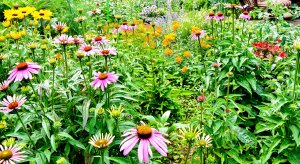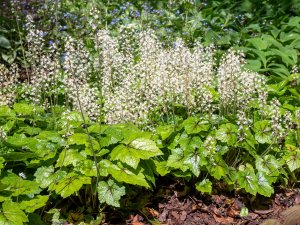Harnessing the Potential of Lawns
April 17, 2024
By: Alexis Olechowski, Interpretive staff
As you stroll through an American neighborhood, what catches your eye? Often, it’s the sight of scattered trees and shrubs amid expansive, meticulously manicured lawns. Traditionally, these lawns have been pristine carpets of neatly trimmed grass, often accompanied by flower beds. While visually appealing, such uniform greenery represents an ecological void. The roots of modern lawns can be traced back to medieval England, where they symbolized wealth by demonstrating landowners’ ability to maintain uncultivated land. Though our society has largely forgotten this historical context, lawns have since become a beloved feature of many single-family homes. In the United States, about 40 million acres are covered by turf grass, exceeding the area of National Parks in the lower 48 states. However, in the face of climate change and other environmental challenges, it’s imperative to reassess our approach to lawn care and seek alternative solutions. Integrating native plants into our existing lawns offers a promising avenue. Let’s delve into the remarkable contributions of native plants to ecosystems and understand why they offer financial savings as well as easier maintenance compared to the grasses commonly found in our lawns, without compromising the manicured appearances we cherish.

Why do grasses fall short?
Native plants play a vital role in supporting healthy ecosystems by providing essential habitats and food sources for a diverse array of wildlife. In contrast to traditional lawn grasses, also known as monoculture lawns, which provide limited ecological value, native plants attract and support various species of birds, butterflies, and beneficial insects. Adding these plants fosters biodiversity in residential areas and promotes the long-term sustainability of local ecosystems. So why do grasses fall short in offering these same benefits? Initially planted with grasses native to England, well-suited to the local soil, rainfall, and temperatures, these lawns eventually spread worldwide. However, these grass species prove less adaptable to diverse climates and soils elsewhere, necessitating significant maintenance efforts. To maintain their lush appearance, people often resort to expensive fertilizers, frequent watering, and chemical treatments, resulting in strain on freshwater resources, environmental pollution and your wallet. Sustainable landscaping, featuring diverse native plant species, offers easier maintenance and reduces the need for harmful chemicals. Integrating native species enhances biodiversity, conserves water, improves soil health, and boosts human well-being. Additionally, low-growing native plants improve air quality by absorbing pollutants, supporting healthier outdoor environments, and reducing respiratory risks for residents all while saving you time and money.

More area means more benefits
By harnessing the potential of lawns to increase pollinator populations and promote biodiversity, we can bridge the gaps created by urbanization and create a more resilient natural world. Expanding pollinator planting beyond flower beds offers significantly more ecological benefits simply because of the amount of space. 80% of all residences in the United States have private lawns, which is about 50,000 square miles or 31,700,000 acres of grass. This vast expanse offers a chance to convert lawns into habitats beneficial for both humans and wildlife, countering the fragmentation resulting from urban development. Fragmentation occurs when parts of a habitat are destroyed, creating barriers that divide ecosystems. Imagine the number of lawns between you and your local nature preserve. Now envision each of those dormant turfgrass lawns transformed into thriving ecosystems teeming with life, connecting your backyard to the preserve. Picture expanded gardens providing sustenance for both humans and wildlife, orchards and wildflower meadows blooming with diversity and serene wooded groves. Envision natural play spaces where urban children can intimately connect with nature, both near their homes and in their backyards. Visualize parks effectively mitigating flooding, urban heat, and pollution, while absorbing more greenhouse gases. Lawns serve as indispensable habitats for pollinators, offering ample room for a diverse array of flowering plants, shrubs, and trees to flourish. Their expansive nature enables the creation of interconnected habitats on a monumental scale, aiding pollinator movement across fragmented urban landscapes. The sun-soaked openness of lawns attracts a broad spectrum of pollinators, from bees and butterflies to hummingbirds and beyond. Through thoughtful landscaping practices and a shared commitment to conservation, we can forge connections between fragmented ecosystems, promoting biodiversity and ensuring a thriving environment for future generations.
Biodiversity and beauty
Biodiverse lawns embody the perfect blend of ecological sustainability and visual allure, dispelling the notion that prioritizing biodiversity must come at the expense of beauty or efficient land use. These lush lawns weave a vibrant tapestry of plant life, enriching outdoor spaces while nurturing environmental vitality. By integrating an array of native species, biodiverse lawns offer a captivating array of colors, textures, and shapes, transforming landscapes into visually dynamic masterpieces that rival traditional monoculture lawns. Remarkably, many native species, including select groundcovers, withstand regular mowing without compromising their health or aesthetic charm similar to conventional grass lawns, all while retaining their inherent benefits. By selecting native plants with compatible growth habits and heights, homeowners can craft lawn-like settings that demand less maintenance and fewer resources than traditional lawns. The integration of native plants into lawns strikes a harmonious balance between aesthetics and environmental stewardship. Envision biodiverse lawns as a refreshing departure from the mundane, ushering us toward greener, more resilient futures and fostering sustainable communities.
Why choose native ground covers:
- Lower cost
- Aesthetics
- Erosion control
- Lower maintenance
- Weed suppression
- Wildlife habitat

How to choose the right plants:
Aesthetic: Explore a diverse array of native grasses, shrubs, flowering perennials, and evergreens to achieve your desired visual effect.
Foot traffic: Ground covers such as sedum, moss, creeping phlox, and creeping thyme, offering both beauty and resilience against moderate foot traffic. Note that these ground covers are as durable compared to robust turfgrasses like Kentucky bluegrass or perennial ryegrass.
Sun exposure: Tailor your choice of ground covers to the specific sunlight conditions of your landscape, selecting varieties that thrive in both shaded sanctuaries and sun-drenched spaces.
Soil: Prioritize understanding your soil composition, then select ground cover varieties meticulously suited to its unique characteristics, ensuring optimal growth and vitality.
Suggested Michigan Native Plants for Ground Cover:
- Wild Strawberry | Fragaria virginiana: Wild strawberries prefer well-drained soil in partial shade to full sun. They can tolerate a wide range of soil types and can thrive in both dry and moist conditions.
- Creeping Phlox | Phlox subulate: Creeping phlox prefers well-drained soil in full sun to partial shade. They prefer slightly acidic soil and are well-suited to rock gardens and sloped areas.
- Wild Geranium | Geranium maculatum: Wild geraniums prefer moist, well-drained soil in partial to full shade. They are often found in woodland settings and can tolerate a wide range of soil types.
- Foamflower | Tiarella cordifolia: Foamflowers prefer moist, well-drained soil in partial to full shade. They prefer slightly acidic soil and are well-suited to woodland gardens and moist areas.
- Canada Anemone | Anemone canadensis: Canada anemones prefer moist, well-drained soil in partial shade to full sun. They are often found in wetland areas and can tolerate a wide range of soil types.
- Pennsylvania Sedge | Carex pensylvanica: Pennsylvania sedge prefers well-drained soil in partial to full shade. They can tolerate a wide range of soil types and are well-suited to dry, sandy areas.
- Bearberry | Arctostaphylos uva-ursi: Bearberry is a low-growing evergreen shrub that prefers well-drained, sandy soil in full sun to partial shade. Bearberry is well-adapted to dry, rocky soils and can tolerate acidic soil. It is also deer resistant and well-adapted to heavily populated areas of deer.
- Little Bluestem Grass | Schizachyrium scoparium: This grass produces fine green-blue foliage and grows up to 2 feet tall. It is a slow-growing plant that is tolerant of drought and heat.
- Creeping thyme | Thymus praecox: will fill your lawn with a fine-leaved mat of dainty pink, white, or purple flowers. Growing 3-6 inches tall, it can be used as a full ground cover, or you can plant it around steppingstones and pathways.
Keep in mind:
- Embracing native plant species tailored to your yard’s unique conditions minimizes the effort needed for their upkeep.
- Opt for ground-hugging native plants that seamlessly integrate with or complement the manicured areas of your lawn.
- Harness the power of native plants to address troublesome spots in your yard, whether parched or waterlogged.
- Transform your lawn with changes as subtle or bold as you desire, effortlessly aligning with your personal aesthetic preferences or HOA guidelines.
- Tending to native plants with a slightly elevated mowing height encourages deep root development, enhancing soil vitality and resilience against drought.
For more information:
https://www.canr.msu.edu/resources/smart_lawns_for_pollinators
https://xerces.org/pollinator-conservation/yards-and-gardens
https://wildseedproject.net/2017/01/native-groundcovers-beauty-biodiversity-ground-level/
https://www.prairienursery.com/plants-seeds/native-plants/groundcover-plants.html
https://extension.colostate.edu/topic-areas/yard-garden/xeriscaping-ground-cover-plants-7-230/
https://www.a2gov.org/departments/Parks-Recreation/NAP/Native-Plants/Pages/NativePlants.aspx
